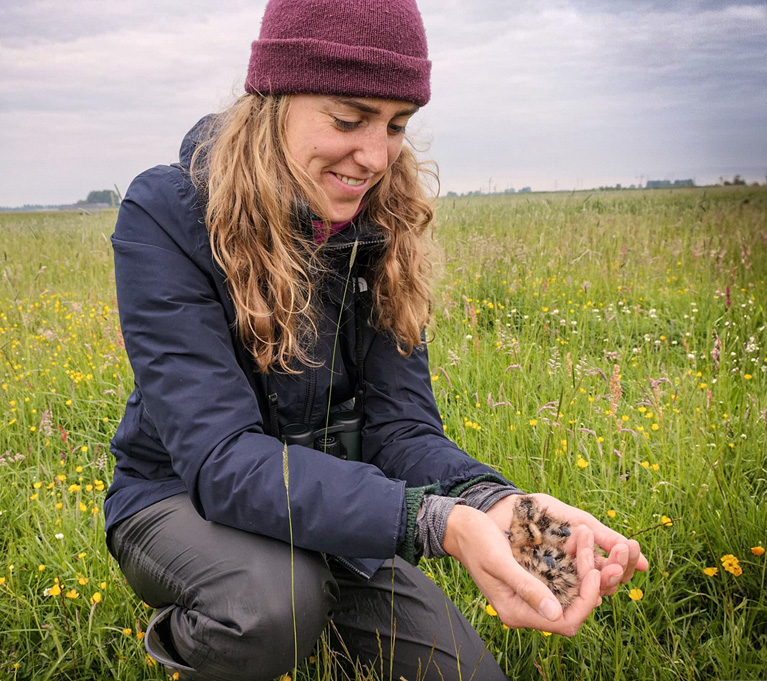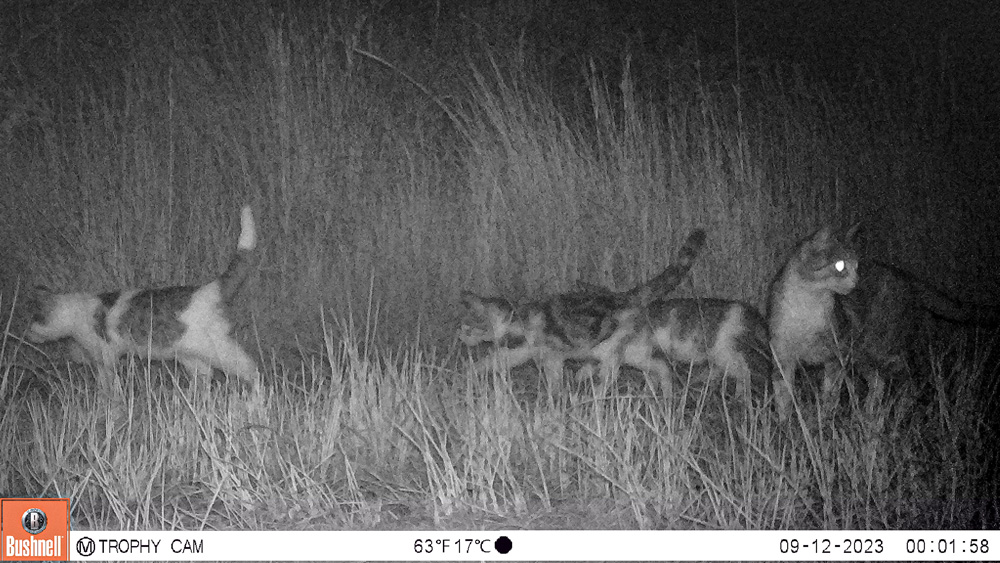
How to save our godwits
These chicks are cat food
The silence that lies over the Dutch meadow is interrupted by the gentle cracking of a shell.
A small beak, then a tiny head and delicate feathers emerge as a young black-tailed godwit hatches. Looking for his mother’s comfort, the chick peeps weakly – unaware of the danger just a few metres away. The cats’ whiskers twitch as it locks its eyes on its unsuspecting meal. The chick peeps one last time as the cat arrives at the nest. Before the cat makes its way home, its delicate white paws move towards the remaining eggs.
It’s a scene PhD student Esther Swankhuisen witnessed through the lenses of a camera trap set up for her research. ‘We knew that cats predate on chicks, but now we know that they also go to the nest and eat the birds’ eggs’, she says – it is one of the preliminary results of her project.
Responsibility
For the past two years, the conservation ecologist has investigated the predator-prey relationship between cats and meadow birds – a topic that has sparked widespread debate in the Netherlands for years.
Now we know that cats also go to the nest and eat the birds’ eggs
She and other researcher want to know whether our beloved pets contribute to the decline in populations of several meadow bird species, such as the black-tailed godwit. There are approximately three million house cats and around 50,000 to 300,000 stray cats in the Netherlands, which are estimated to kill 32 birds per minute.
‘The number of meadow birds declines every year’, Swankhuisen stresses. ‘We have to do something.’ According to her, the Netherlands has a special responsibility, as 80 percent of West Europe´s black-tailed godwits breed here. While intensive agriculture and predators like foxes are known issues, the effect cats have on these vulnerable species remains under-researched in the Netherlands, she says.
GPS loggers
Addressing this, Swankhuisen is conducting three studies simultaneously; three puzzle pieces that are funded by the Ministry of Agriculture with the goal of providing evidence-based policy recommendations. Recognising the social sensitivity of the topic, Swankhuisen collaborates with conservation organisations, volunteers, and locals. The work has made her realise how important it is to share her results not only with the scientific community, but also with society.
Some of these initial results are now open for sharing with the public. The first part of Swankhuisen’s research focuses on tracking both cats and birds using GPS loggers and radio tags, as well as camera traps. That has yielded some unexpected results.
‘Most owners say their cat only stays in the garden or doesn’t go further than the streets. But our trackers show that they sometimes walk several kilometres. Some are away for days, even older cats. This happens during the day and night’, she says. The question is how those travels influence the fate of meadow birds.

Camera traps
To get the most complete picture of the situation in the Dutch meadows, Swankhuisen and her team of bachelor and master students have placed eighty camera traps across two areas in Groningen and Friesland. In the breeding season between March and June, these record nests and the entrances to the fields. As soon as a camera detects movement, like an approaching cat, it takes a picture.
Owners say their cat stays in the garden, but our trackers show otherwise
This way, in just one year, the researchers accumulated five million pictures to analyse. Thankfully, they’re assisted by an AI that filters out any photos without felines. The preliminary result: many, many cats go into the fields and not only prey on the chicks, but also eat the birds’ eggs.
Another way to provide the debate with data is to determine cats’ diets. Swankhuisen analysed samples of cat faeces from five different meadow bird areas in the Netherlands to identify the DNA of the animals the cats ate.
She found two endangered bird species: the Northern shoveler and the Meadow pipit. The cats also ate a rabbit and a hare species, which are both classified as near threatened in the Netherlands. They most likely catch and eat the young of these species, Swankhuisen points out.
Shooting cats
The problem of cats killing wildlife has been acknowledged for some time, and so some municipalities have taken action. For instance, Houten and Groningen encourage citizens to keep their cats inside at night during the breeding season.
The province of Friesland went a step further by shooting feral cats and catching house cats in meadows. That might seem drastic, but Swankhuisen says: ‘It is very important to investigate all methods to lower the impact of cats, including shooting. It is also important to find out whether there is a more animal friendly one that works, though.’
As long as house cats can just go outside, there’s always a new influx
The third facet of Swankhuisen’s research includes a method that might fit that bill. Together with the Dutch Stray Cat Foundation (Stichting Zwerfkatten Nederland) and National Park Schiermonnikoog she aims to reduce the island’s cat population. They put up cages and trap the cats, which are then brought to an animal shelter on the mainland and can be adopted if they are healthy and not too feral. The goal is to determine how the wildlife on the island is affected when there are fewer cats roaming around.
However, while Swankhuisen’s team has caught approximately seventy cats over the last two years – averaging one every ten nights – the number of animals they catch does not decrease. They have to catch cats more quickly than they reproduce, which is a challenge, since a cat as young as six months can start having multiple litters a year.
Costly method
An additional problem is that many residents of Schiermonnikoog still own house cats that go outdoors. ‘As long as house cats that aren’t neutered can just go outside, we can try to catch all the feral cats, but then there’s always a new influx of house cats.’
So during the project, the focus shifted to determining whether catching the cats is an effective method. ‘It is very costly in terms of money and time, and in the end it might not really be animal friendly because it can be quite stressful for them.’
The uncomfortable question arising at this point: How far should we go to keep a predator away from its prey? Swankhuisen will continue her efforts to answer this question scientifically – all with the goal that a freshly hatched chick might survive longer than a few days in the future.